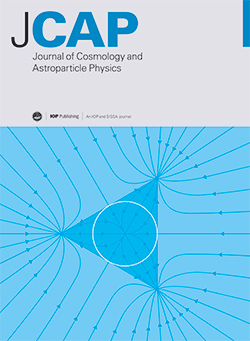IF 5.3
2区 物理与天体物理
Q1 ASTRONOMY & ASTROPHYSICS
Journal of Cosmology and Astroparticle Physics
Pub Date : 2025-03-14
DOI:10.1088/1475-7516/2025/03/024
引用次数: 0
摘要
由于现有加速器数据的限制,强子相互作用模型对宇宙射线诱发的气流淋浴的预测包含固有的不确定性。这导致使用每种模型模拟的气流淋浴存在差异。为了跟踪这些差异,人们已经开展了许多研究,对气淋的发展或粒子含量进行调查。在这项工作中,我们提出了一种新的方法,通过观测强子气流淋浴产生的 IACT 图像来寻找模型之间的差异和相似之处。我们将模拟 H.E.S.S. 作为一个示例场景,通过研究相机图像的变量,我们找到了突出模型之间差异的潜在指标。像素数、Hillas 图像大小和密度显示了模型之间的最大差异。然后,我们通过合并所有变量并使用提升决策树,进一步探索模型的(不)兼容性。在质子方面,与 QGSJET-II04 和 Sybill 2.3d 相比,EPOS-LHC 的分类器输出结果存在明显差异。对于氦和氮,QGSJET-II04 被证明是异常值。在硅和铁方面没有发现明显差异。在重建的阵雨参数相空间中,各模型之间(不)兼容的分布情况表明,有针对性的搜索是富有成效的,重建能量为几TeV的阵雨和重建核心更接近大望远镜的阵雨会呈现出最大的分离力。对第一次相互作用参数分布的研究表明,EPOS-LHC 和 QGSJET-II04 导致质子第一次相互作用的倍率和高度以及氦和氮的弹性和中性质子携带的能量的分布明显不同。本文章由计算机程序翻译,如有差异,请以英文原文为准。
Investigating the effect of hadronic models on IACT images
The predictions of hadronic interaction models for cosmic-ray induced air showers contain inherent uncertainties due to limitations of available accelerator data. This leads to differences in shower simulations using each of those models. Many studies have been carried out to track those differences by investigating the shower development or the particle content. In this work, we propose a new approach to search for discrepancies and similarities between the models, via the IACT images resulting from the observations of hadronic air showers. We use simulations of H.E.S.S. as a show-case scenario and, by investigating variables of the camera images, we find potential indicators to highlight differences between models. Number of pixels, Hillas image size, and density showed the largest difference between the models. We then further explore the (in)compatibility of the models by combining all the variables and using Boosted Decision Trees. For protons, a significant difference in the classifier output is found for EPOS-LHC when compared to both QGSJET-II04 and Sybill 2.3d. For helium and nitrogen, QGSJET-II04 is shown to be the outlier case. No significant differences are found for silicon and iron. The distribution of (in)compatibility between the models in the phase space of reconstructed shower parameters shows that a targeted search can be fruitful, with showers with reconstructed energies of a few TeV and reconstructed core closer to the large telescope presenting the largest power of separation. An investigation of the distribution of first interaction parameters has shown that EPOS-LHC and QGSJET-II04 result in significantly different distributions of multiplicity and height of first interaction for protons and elasticity and fraction of energy carried by neutral pions for helium and nitrogen.
求助全文
通过发布文献求助,成功后即可免费获取论文全文。
去求助
来源期刊

Journal of Cosmology and Astroparticle Physics
地学天文-天文与天体物理
CiteScore
10.20
自引率
23.40%
发文量
632
审稿时长
1 months
期刊介绍:
Journal of Cosmology and Astroparticle Physics (JCAP) encompasses theoretical, observational and experimental areas as well as computation and simulation. The journal covers the latest developments in the theory of all fundamental interactions and their cosmological implications (e.g. M-theory and cosmology, brane cosmology). JCAP''s coverage also includes topics such as formation, dynamics and clustering of galaxies, pre-galactic star formation, x-ray astronomy, radio astronomy, gravitational lensing, active galactic nuclei, intergalactic and interstellar matter.
 求助内容:
求助内容: 应助结果提醒方式:
应助结果提醒方式:


